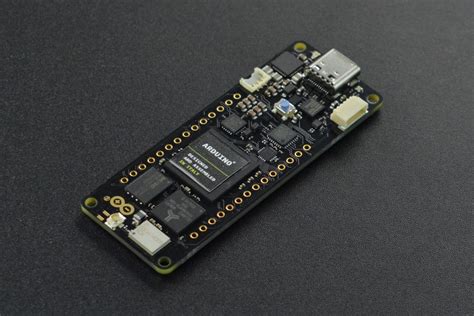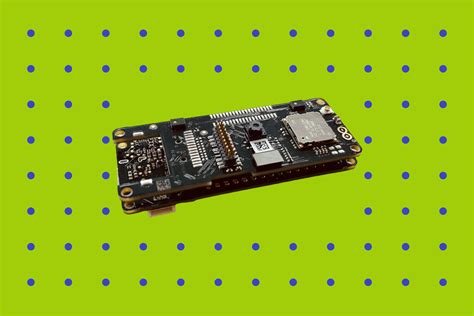Introduction to the Arduino Portenta H7
The Arduino Portenta H7 is a game-changing development board that brings the power and flexibility of Arduino to production-grade applications. This board is designed to bridge the gap between prototyping and industrial-grade performance, making it an ideal choice for developers who want to create high-performance, low-power applications.
The Portenta H7 is powered by a dual-core ARM Cortex-M7 and Cortex-M4 processor, providing unparalleled processing power and energy efficiency. It also features a wide range of connectivity options, including Wi-Fi, Bluetooth, Ethernet, and USB, as well as support for Arduino and MicroPython programming.
Key Features of the Arduino Portenta H7
The Arduino Portenta H7 is packed with features that make it a powerful and versatile development board. Here are some of the key features:
Dual-Core Processing
The Portenta H7 features a dual-core ARM Cortex-M7 and Cortex-M4 processor, running at 480 MHz and 240 MHz respectively. This provides ample processing power for even the most demanding applications, while still maintaining low power consumption.
Connectivity Options
The board includes a wide range of connectivity options, including:
- Wi-Fi (802.11 b/g/n)
- Bluetooth 5.0
- Ethernet (10/100 Mbps)
- USB Host and Device
- CAN Bus
- I2C/SPI/UART
This makes it easy to connect the Portenta H7 to other devices and networks, enabling a wide range of applications.
Arduino and MicroPython Support
The Portenta H7 supports both Arduino and MicroPython programming, making it easy for developers to get started with the board. The Arduino IDE provides a familiar development environment for those already familiar with Arduino, while MicroPython offers a more flexible and powerful programming option.
Low Power Consumption
Despite its high performance, the Portenta H7 is designed for low power consumption. It includes a variety of power-saving features, such as sleep modes and dynamic clock gating, which help to extend battery life and reduce overall power consumption.
Expandability
The Portenta H7 includes a variety of expansion options, including:
- 2x Cortex-M7 I/O Headers
- Arduino MKR Headers
- High-Density Connectors
- NXP NFC Extension Connector
These expansion options make it easy to add additional functionality to the board, such as sensors, actuators, and communication modules.

Applications of the Arduino Portenta H7
The Arduino Portenta H7 is suitable for a wide range of applications, from industrial automation to edge computing. Here are some examples of how the board can be used:
Industrial Automation
The Portenta H7’s high performance and low power consumption make it an ideal choice for industrial automation applications. It can be used to control machines, monitor sensors, and communicate with other devices on the factory floor.
Edge Computing
The board’s powerful processing capabilities and connectivity options make it well-suited for edge computing applications. It can be used to process data from sensors and other devices at the edge of the network, reducing latency and bandwidth requirements.
Robotics
The Portenta H7 can be used to control robots and other autonomous systems. Its dual-core processing and low power consumption make it an ideal choice for mobile robots that need to operate for extended periods of time.
IoT Gateways
The board’s wide range of connectivity options make it an excellent choice for IoT gateway applications. It can be used to collect data from sensors and other devices, process that data locally, and then send it to the cloud for further analysis.

Comparison to Other Arduino Boards
The Arduino Portenta H7 represents a significant step forward compared to other Arduino boards. Here’s how it compares to some of the most popular Arduino boards:
| Board | Processor | Clock Speed | RAM | Flash | Connectivity |
|---|---|---|---|---|---|
| Portenta H7 | Dual Cortex-M7/M4 | 480/240 MHz | 8 MB | 16 MB | Wi-Fi, Bluetooth, Ethernet, USB, CAN |
| Arduino Uno | ATmega328P | 16 MHz | 2 KB | 32 KB | USB |
| Arduino Mega | ATmega2560 | 16 MHz | 8 KB | 256 KB | USB |
| Arduino Nano 33 IoT | SAMD21 Cortex-M0+ | 48 MHz | 32 KB | 256 KB | Wi-Fi, Bluetooth, USB |
As you can see, the Portenta H7 offers significantly more processing power, memory, and connectivity options compared to other Arduino boards. This makes it a more suitable choice for demanding applications that require high performance and flexibility.

Getting Started with the Arduino Portenta H7
Getting started with the Arduino Portenta H7 is easy, thanks to its support for Arduino and MicroPython programming. Here’s a quick guide to getting started:
- Download and install the Arduino IDE from the official Arduino website.
- Connect the Portenta H7 to your computer using a USB cable.
- Open the Arduino IDE and select the Portenta H7 from the list of available boards.
- Write your code using the Arduino programming language or MicroPython.
- Upload the code to the Portenta H7 using the Arduino IDE.
That’s it! You’re now ready to start developing with the Arduino Portenta H7.
FAQ
What is the Arduino Portenta H7?
The Arduino Portenta H7 is a high-performance development board designed for industrial-grade applications. It features a dual-core ARM Cortex-M7 and Cortex-M4 processor, a wide range of connectivity options, and support for Arduino and MicroPython programming.
What can I use the Arduino Portenta H7 for?
The Portenta H7 is suitable for a wide range of applications, including industrial automation, edge computing, robotics, and IoT gateways. Its high performance and low power consumption make it an ideal choice for demanding applications that require flexibility and reliability.
How does the Portenta H7 compare to other Arduino boards?
The Portenta H7 offers significantly more processing power, memory, and connectivity options compared to other Arduino boards. It features a dual-core processor running at up to 480 MHz, 8 MB of RAM, 16 MB of flash memory, and support for Wi-Fi, Bluetooth, Ethernet, USB, and CAN.
Is the Arduino Portenta H7 easy to use?
Yes, the Portenta H7 is designed to be easy to use, even for those new to Arduino programming. It supports both Arduino and MicroPython programming, and can be programmed using the familiar Arduino IDE.
How much does the Arduino Portenta H7 cost?
The Arduino Portenta H7 is priced at around $100 USD, which is more expensive than many other Arduino boards. However, its high performance and industrial-grade features make it a worthwhile investment for those who need a reliable and flexible development board for demanding applications.
Conclusion
The Arduino Portenta H7 is a powerful and versatile development board that brings Arduino into the realm of industrial-grade applications. With its dual-core processing, wide range of connectivity options, and support for Arduino and MicroPython programming, it offers unparalleled flexibility and performance for demanding applications.
Whether you’re working on industrial automation, edge computing, robotics, or IoT gateways, the Portenta H7 has the features and capabilities you need to get the job done. And with its easy-to-use programming environment and extensive documentation, it’s accessible to developers of all skill levels.
If you’re looking for a high-performance development board that can handle even the most demanding applications, the Arduino Portenta H7 is definitely worth considering. With its combination of power, flexibility, and ease of use, it’s sure to become a go-to choice for developers around the world.

No responses yet